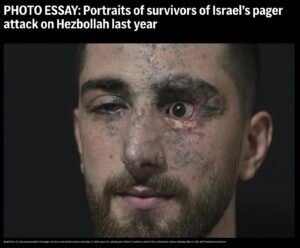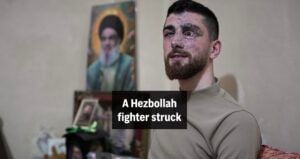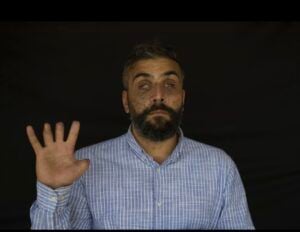RSS
Maimed & Fingerless: The Associated Press Publishes a Sickening Shrine to Hezbollah

A man gestures the victory sign as he holds a Hezbollah flag, on the second day of the ceasefire between Israel and Iran-backed group Hezbollah, in Tyre, southern Lebanon, Nov. 28, 2024. Photo: REUTERS/Aziz Taher
There are moments in media criticism when the usual words — bias, omission, misleading framing — feel inadequate. Because this isn’t just about bias. It’s about a line crossed. It’s about a piece of so-called journalism so grotesque, so inverted in its moral compass, that it demands a different kind of response.
The Associated Press has published a photo essay titled “Portraits of survivors of Israel’s pager attack on Hezbollah last year.” It features carefully staged portraits and sorrowful quotes — not just from Hezbollah operatives themselves, but also from a few of their relatives.
Let’s not forget this is a US- and EU-designated terror organization, and the men were injured in a precision Israeli strike that neutralized dozens of Hezbollah fighters who were using encrypted pagers to coordinate attacks on Israeli civilians.
But the AP doesn’t frame them as terrorists. It casts them as victims. As tragic figures. As men whose disfigured hands deserve your sympathy.
It is repulsive propaganda. Nothing more, nothing less.
We’re not going to walk you through what’s wrong with this piece. It’s too obvious. The entire thing is a distortion. Every image, every quote, every omission — from the total lack of context about Hezbollah’s crimes, including the fact that these very pagers were used to orchestrate lethal attacks on Israelis, to the aesthetic choices that frame mutilated killers in dramatic, reverent lighting — is an insult.
An insult to the thousands of Israelis murdered or maimed by Hezbollah. To the innocent Lebanese civilians crushed under its rule. And to the readers themselves, because how many millions around the world have been directly or indirectly torn apart by Islamist terrorism?


The Aestheticization of Terror
The portraits are the first clue. Each fighter, or relative of a fighter, is photographed against a pitch-black background, lit just enough to highlight scars, stumps, and furrowed brows. Their eyes are cast downward or off into the middle distance. They are composed. Thoughtful. Vulnerable.
There is no blood. No chaos. No evidence of what came before. Just the frozen dignity of men, women, and teenagers supposedly broken by war.
This is not journalism. It is image-crafting. And it works.

Now contrast that with how Israeli victims of Hezbollah are typically shown in Western media, if they’re shown at all. Blurry photos from attack scenes. Names barely mentioned. Faces rarely shown.
But the AP found the time, the resources, and the artistic vision to give Hezbollah fighters a studio-style shoot and a global platform. The goal was simple: to soften their image, obscure their crimes, and make you forget who they are — so you remember only how they look now.
.@AP looked at terrorists who helped murder Israelis and thought:
“Let’s interview their mothers.”
No mention of the victims. No mention of the terror.
Just tears for Hezbollah.
This is how you sanitize evil. pic.twitter.com/t1GbrxXbCR— HonestReporting (@HonestReporting) August 6, 2025
The Inversion of Victim and Aggressor
One of the men featured, Mahdi Sheri, 23, a Hezbollah member, laments that he can no longer return to his former job on the front line. “Now,” the AP reports with near admiration, “Hezbollah is helping him find a new job.”
Other captions allude to trauma and paint a picture of resilience. Even the children of terrorists, AP notes, “now fear coming near their fathers.” As if the real tragedy isn’t the terror their fathers unleashed — but the fact that their children are afraid of their monstrous parents.
Not once does the AP mention what these men were doing before they were injured: actively working to kill Israelis.
These were not bystanders caught in crossfire. These were operatives of an Iranian-backed terror group, engaged in covert operations using encrypted pagers, the same technology Hezbollah has used for decades to coordinate rocket fire and ambushes targeting civilians.
But instead of reporting that fact, the AP chose to wrap them in tragedy and give them the space to monologue about their pain.
So allow us to do the job they wouldn’t.
The Real Victims: Murdered by Hezbollah
-
241 US Marines and 58 French paratroopers, serving in a multinational peacekeeping force, murdered in the Beirut barracks bombing in 1983.
-
114 people killed in the Israeli Embassy bombing (1992) and the AMIA Jewish Center bombing (1994) in Buenos Aires.
-
19 US Air Force personnel murdered in the Khobar Towers bombing in Saudi Arabia in 1996.
-
Eight Israeli soldiers murdered in a cross-border raid, with two others taken hostage and later killed — the attack that triggered the 2006 Lebanon War, during which 43 Israeli civilians and 121 IDF soldiers were killed by Hezbollah rocket fire.
-
Dozens of Israeli civilians and security personnel killed in Hezbollah attacks during the 2023–2024 Israel–Hezbollah conflict, launched after the October 7 Hamas massacre. Over 60,000 Israeli residents of the north were displaced.
-
In July 2024, a Hezbollah rocket struck a soccer field in Majdal Shams, killing at least 12 children.
This is not a full list.
The media finds its focus when photographing the wounded bodies of terrorists. But it falls silent when it comes to their victims.
Call It What It Is
This isn’t journalism. It’s image laundering — the glorification of terror, repackaged as human interest.
And it’s not new.
We’ve seen it before: when The New York Times ran glowing features on Hamas-linked “journalists,” when the BBC called Qassam Brigade commanders “fighters,” and when Reuters gave Islamic Jihad operatives a platform without ever asking why they fire rockets at Israeli kindergartens.
It’s the same playbook: Humanize the perpetrator. Aestheticize the violence. Erase the victims. Call it balance.
But this isn’t balance. It’s complicity.
The Associated Press didn’t just publish a photo essay. It published a shrine.
The author is a contributor to HonestReporting, a Jerusalem-based media watchdog with a focus on antisemitism and anti-Israel bias — where a version of this article first appeared.
RSS
After False Dawns, Gazans Hope Trump Will Force End to Two-Year-Old War

Palestinians walk past a residential building destroyed in previous Israeli strikes, after Hamas agreed to release hostages and accept some other terms in a US plan to end the war, in Nuseirat, central Gaza Strip October 4, 2025. Photo: REUTERS/Mahmoud Issa
Exhausted Palestinians in Gaza clung to hopes on Saturday that US President Donald Trump would keep up pressure on Israel to end a two-year-old war that has killed tens of thousands and displaced the entire population of more than two million.
Hamas’ declaration that it was ready to hand over hostages and accept some terms of Trump’s plan to end the conflict while calling for more talks on several key issues was greeted with relief in the enclave, where most homes are now in ruins.
“It’s happy news, it saves those who are still alive,” said 32-year-old Saoud Qarneyta, reacting to Hamas’ response and Trump’s intervention. “This is enough. Houses have been damaged, everything has been damaged, what is left? Nothing.”
GAZAN RESIDENT HOPES ‘WE WILL BE DONE WITH WARS’
Ismail Zayda, 40, a father of three, displaced from a suburb in northern Gaza City where Israel launched a full-scale ground operation last month, said: “We want President Trump to keep pushing for an end to the war, if this chance is lost, it means that Gaza City will be destroyed by Israel and we might not survive.
“Enough, two years of bombardment, death and starvation. Enough,” he told Reuters on a social media chat.
“God willing this will be the last war. We will hopefully be done with the wars,” said 59-year-old Ali Ahmad, speaking in one of the tented camps where most Palestinians now live.
“We urge all sides not to backtrack. Every day of delay costs lives in Gaza, it is not just time wasted, lives get wasted too,” said Tamer Al-Burai, a Gaza City businessman displaced with members of his family in central Gaza Strip.
After two previous ceasefires — one near the start of the war and another earlier this year — lasted only a few weeks, he said; “I am very optimistic this time, maybe Trump’s seeking to be remembered as a man of peace, will bring us real peace this time.”
RESIDENT WORRIES THAT NETANYAHU WILL ‘SABOTAGE’ DEAL
Some voiced hopes of returning to their homes, but the Israeli military issued a fresh warning to Gazans on Saturday to stay out of Gaza City, describing it as a “dangerous combat zone.”
Gazans have faced previous false dawns during the past two years, when Trump and others declared at several points during on-off negotiations between Hamas, Israel and Arab and US mediators that a deal was close, only for war to rage on.
“Will it happen? Can we trust Trump? Maybe we trust Trump, but will Netanyahu abide this time? He has always sabotaged everything and continued the war. I hope he ends it now,” said Aya, 31, who was displaced with her family to Deir Al-Balah in the central Gaza Strip.
She added: “Maybe there is a chance the war ends at October 7, two years after it began.”
RSS
Mass Rally in Rome on Fourth Day of Italy’s Pro-Palestinian Protests

A Pro-Palestinian demonstrator waves a Palestinian flag during a national protest for Gaza in Rome, Italy, October 4, 2025. Photo: REUTERS/Claudia Greco
Large crowds assembled in central Rome on Saturday for the fourth straight day of protests in Italy since Israel intercepted an international flotilla trying to deliver aid to Gaza, and detained its activists.
People holding banners and Palestinian flags, chanting “Free Palestine” and other slogans, filed past the Colosseum, taking part in a march that organizers hoped would attract at least 1 million people.
“I’m here with a lot of other friends because I think it is important for us all to mobilize individually,” Francesco Galtieri, a 65-year-old musician from Rome, said. “If we don’t all mobilize, then nothing will change.”
Since Israel started blocking the flotilla late on Wednesday, protests have sprung up across Europe and in other parts of the world, but in Italy they have been a daily occurrence, in multiple cities.
On Friday, unions called a general strike in support of the flotilla, with demonstrations across the country that attracted more than 2 million, according to organizers. The interior ministry estimated attendance at around 400,000.
Italy’s right-wing government has been critical of the protests, with Prime Minister Giorgia Meloni suggesting that people would skip work for Gaza just as an excuse for a longer weekend break.
On Saturday, Meloni blamed protesters for insulting graffiti that appeared on a statue of the late Pope John Paul II outside Rome’s main train station, where Pro-Palestinian groups have been holding a protest picket.
“They say they are taking to the streets for peace, but then they insult the memory of a man who was a true defender and builder of peace. A shameful act committed by people blinded by ideology,” she said in a statement.
Israel launched its Gaza offensive after Hamas terrorists staged a cross border attack on October 7, 2023, killing some 1,200 people and taking 251 people hostage.
RSS
Hamas Says It Agrees to Release All Israeli Hostages Under Trump Gaza Plan

Smoke rises during an Israeli military operation in Gaza City, as seen from the central Gaza Strip, October 2, 2025. Photo: REUTERS/Dawoud Abu Alkas
Hamas said on Friday it had agreed to release all Israeli hostages, alive or dead, under the terms of US President Donald Trump’s Gaza proposal, and signaled readiness to immediately enter mediated negotiations to discuss the details.


